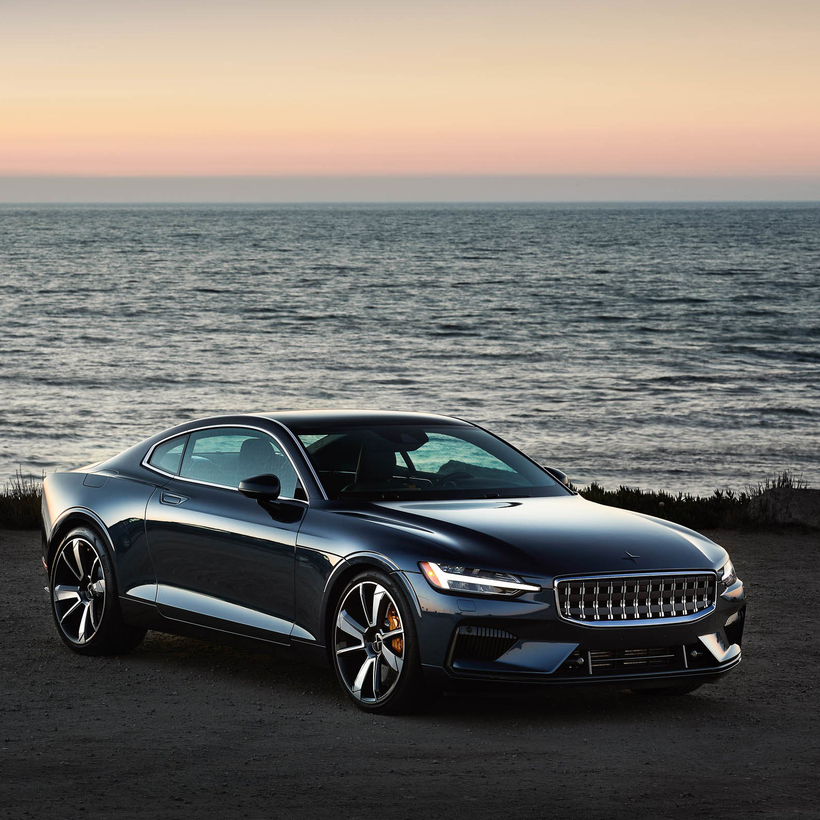In an industry bristling with opportunity for financial ruin, the long innings of Sweden’s Volvo Cars (founded 1927) stand in proud exception, reminding us that when it comes to survival, size isn’t everything. With sales volumes vastly smaller than the big car companies’, Volvo has consistently managed through the years to offer competitive automobiles while always marching to the beat of its own slightly eccentric, safety-obsessed drum machine.
Polestar 1, a new limited-edition, gas-electric-hybrid coupe, is, if anything, a more radical departure from the mainstream, but that’s as intended. It’s the first of Volvo’s new electric-car line, Polestar, a hand-assembled, low-production experiment of sorts. Meant to launch an ambitious future-forward enterprise with significantly greater sales volume than this appetite-whetter, Polestar owes its existence in the first place to the timely arrival of the electric-car smarts and deep pockets of Volvo’s new Chinese owner, Zhejiang Geely Holding Group Co., Ltd.
Volvo has consistently managed through the years to offer competitive automobiles while always marching to the beat of its own slightly eccentric, safety-obsessed drum machine.
Geely bought Sweden’s biggest car-maker in 2010 from Ford (which snagged the theretofore-independent company in 1999 and lost it in the Great Recession) and today owns the whole shooting match, Volvo and Polestar both. Polestar 1 is even built in Chengdu. But the car, a stylish two-door said to draw inspiration from Volvo’s own fondly remembered P1800 sports car (1961–1973), remains very much the Swedes’ baby, as does the Chinese factory from which it emerges.
Polestar is a reflection of Geely’s desire to compete in the luxury realm, where the biggest profits lie, as well as its high regard for Volvo’s Swedish managers and engineers, which makes this takeover different in kind, for instance, from General Motors’ purchase of Volvo’s now defunct Swedish competitor, Saab.
The Evidence So Far
That 1990s acquisition saw the surgical removal of Saab’s skilled engineering brains and the arrival on showroom floors of a most un-Saab-like S.U.V., a re-badged version of the execrable Chevy Trailblazer. Called the 9-7X, it fooled no one and was nearly unsalable. By contrast, name and corporate governance structures aside, Polestar amounts to a high-end electric Volvo, a genuine article underwritten by Chinese money. On the basis of the evidence so far, that’s a good thing.

Polestar 1 is not just substantially larger than the classic P1800 coupe popularized by The Saint, the television series that launched Roger Moore, a future James Bond. It’s also a plug-in hybrid that offers a best-in-the-business 70 miles of battery range, meaning that if you had a 35-mile commute—and charged overnight—you might remain in electric mode always, never switching over to its gasoline engine and never needing to visit a gas station. This last, those with electric-car experience can confirm, is its own reward.
The plug-in hybrid is substantially larger than the classic P1800 coupe popularized by The Saint, the television series that launched a future James Bond.
Superior hybrid-electric range, plus an undeniably stiff $156,500 price tag, makes Polestar 1 different not just from all previous Volvos but also from all future Polestars. Electric-only, with today’s requisite (for a state-of-the-art electric car) 250-mile-range minimum, an imminent higher-volume Polestar 2 will be priced so at least some mere mortals might afford one—think $60,000 or thereabouts, followed by a cheaper version at around $45,000, which puts the 2 right in Tesla 3 territory.
In the meantime, Polestar 1—of which but 500 examples will be built a year, for a total of just 1,500 over three years—will travel 540 miles on a combination of gasoline and battery power, a useful number for a car that proved over the course of a recent day’s drive in Northern California to be even more competent in the long-distance, grand-touring assignment than in a role as a green commuter car.
Polestar 1—of which but 500 examples will be built a year, for a total of just 1,500 over three years—will travel 540 miles on a combination of gasoline and battery power.
As important as its good looks, Polestar 1 also constitutes the sportiest, best-handling, most powerful car Volvo has ever been associated with, taking just 4.2 seconds to reach 60 miles per hour. This is in spite of its nearly 5,200-pound curb weight, the price of all those heavy batteries on board. It’s a figure that would be even higher were it not for extensive use of lightweight materials, including a frame made of lightweight steel and carbon-fiber elements, an aluminum suspension, and body panels made of super-strong, ultra-lightweight carbon-impregnated plastic.
Strength and Safety Assured
Being a Volvo at heart, Polestar 1’s strength and safety are assured. But by placing its hefty battery pack in the central tunnel and over the rear axle, a low center of gravity is also achieved, while carbon-fiber panels enhance body stiffness, saving 507 pounds of weight and making for exceptional structural rigidity, not just to the benefit of safety but also ride and handling.

Weight is the enemy of ride and handling in cars, as it is with agility in people. And even though it is a heavy thing, Polestar 1 felt anything but obese. Its ride character is smooth, sophisticated, and notably well controlled for a large vehicle, its steering sharper than that of any Volvo we’ve ever known. And the Polestar’s improbably limber chassis hosts a definitively un-nerd-like 619 horsepower, giving the hybrid a profound sense of urgency when accelerating.
Power comes from a four-cylinder gasoline engine displacing a comparatively modest two liters, but the engine punches well above its weight thanks to supercharging and turbocharging, with two electric motors powering the rear axle, plus a starter/generator also on hand to deliver further “go” to the proceedings. The result is safe, seamless, and predictably mental as, given the chance, this first-ever Polestar will hit an electronically governed maximum speed of 155 miles per hour, even if odds are you won’t go that fast. This does not jibe with the main Volvo brand’s recent pledge to limit all its cars to 112 m.p.h. top speeds in the interests of safety, beginning in 2020. But we’re not complaining. Polestar 1, for all its eccentricity, can compete with more conventional, and equally expensive, grand-touring cars, straight-up stratospheric top speeds included.
Also: Luxury
That’s because it’s also got luxury—another virtue not typically associated with Volvo—down. Wide doors give surprisingly easy access to its substantial front bucket seats, covered in Nappa leather (your choice of Charcoal or Zinc), and better-than-average entry to its less commodious but hardly claustrophobic rear pew. A large, modern touch screen dominates the front cabin, though regular, electronic gauges remain before the driver. A 15-speaker Bowers & Wilkins audio system rocks the house for you, while a crystal selector, made by hand, Polestar says, helps you select the gears of its eight-speed transmission automatically, or by your lonesome, as the mood strikes. Above you, a glass roof offers panoramic views to lighten matters.

Color choices are limited to five, and matte finish, at $5,000, is the only available option. Somewhat disappointingly, carbon-fiber accents dot Polestar 1’s interior. Increasingly popular with car-makers, carbon fiber is considered an exotic material, and is certainly expensive to make, but, to be frank, as a design element it’s a cliché that leaves me cold. On the other hand, if you just have to have it in areas other than where it really counts, authenticity points to Polestar for using the real stuff. Indeed, the only thing worse than carbon-fiber trim in a new car—and it’s a lot worse—is ersatz carbon-fiber trim, of which there is plenty out there.
In sum, Polestar 1 is a tasteful and exceedingly comfortable environment from which to tackle the business of driving one’s self into the future. There’s something just a touch recherché in this era of electric cars for an electric-car brand to launch with a hybrid, but this car not only introduces the brand and elements of the electrified concept; it also stands on its own merit. Only the coldest heart can hold Polestar 1’s hybrid nature against it. And, by hook or by crook, Volvo appears to be well on the way, once again, to grandfathering itself into the future.
Jamie Kitman is a car columnist for AIR MAIL


